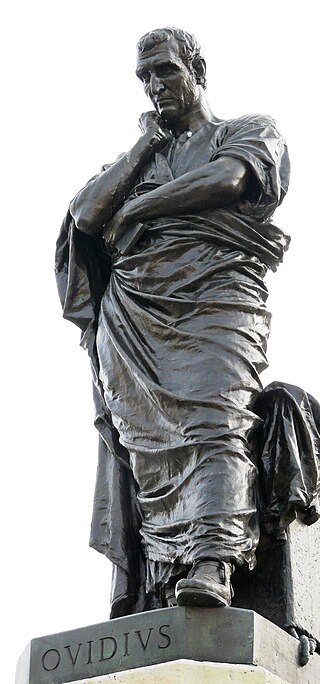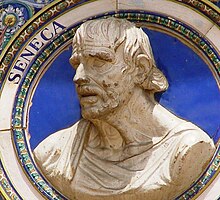
Rhetoric is the art of persuasion. It is one of the three ancient arts of discourse (trivium) along with grammar and logic/dialectic. As an academic discipline within the humanities, rhetoric aims to study the techniques that speakers or writers use to inform, persuade, and motivate their audiences. Rhetoric also provides heuristics for understanding, discovering, and developing arguments for particular situations.

Libanius was a teacher of rhetoric of the Sophist school in the Eastern Roman Empire. His prolific writings make him one of the best documented teachers of higher education in the ancient world and a critical source of history of the Greek East during the 4th century AD. During the rise of Christian hegemony in the later Roman Empire, he remained unconverted and in religious matters was a pagan Hellene.
A sophist was a teacher in ancient Greece in the fifth and fourth centuries BCE. Sophists specialized in one or more subject areas, such as philosophy, rhetoric, music, athletics and mathematics. They taught arete, "virtue" or "excellence", predominantly to young statesmen and nobility.

Lucius Annaeus Seneca the Younger, usually known mononymously as Seneca, was a Stoic philosopher of Ancient Rome, a statesman, dramatist, and in one work, satirist, from the post-Augustan age of Latin literature.

Marcus Fabius Quintilianus was a Roman educator and rhetorician born in Hispania, widely referred to in medieval schools of rhetoric and in Renaissance writing. In English translation, he is usually referred to as Quintilian, although the alternate spellings of Quintillian and Quinctilian are occasionally seen, the latter in older texts.
Choricius of Gaza was a Gaza-based Greek sophist and rhetorician of Late Antiquity. With writings dating to the early sixth century, he flourished in the time of Anastasius I as a scholar and public orator. He is considered as part of the Rhetorical School of Gaza, of which he later became the chair.

Isocrates was an ancient Greek rhetorician, one of the ten Attic orators. Among the most influential Greek rhetoricians of his time, Isocrates made many contributions to rhetoric and education through his teaching and written works.
Lucius Annaeus Seneca the Elder, also known as Seneca the Rhetorician, was a Roman writer, born of a wealthy equestrian family of Corduba, Hispania. He wrote a collection of reminiscences about the Roman schools of rhetoric, six books of which are extant in a more or less complete state and five others in epitome only. His principal work, a history of Roman affairs from the beginning of the Civil Wars until the last years of his life, is almost entirely lost to posterity. Seneca lived through the reigns of three significant emperors; Augustus, Tiberius and Caligula. He was the father of Lucius Junius Gallio Annaeanus, best known as a Proconsul of Achaia; his second son was the dramatist and Stoic philosopher Seneca the Younger (Lucius), who was tutor of Nero, and his third son, Marcus Annaeus Mela, became the father of the poet Lucan.

The Second Sophistic is a literary-historical term referring to the Greek writers who flourished from the reign of Nero until c. 230 AD and who were catalogued and celebrated by Philostratus in his Lives of the Sophists. However, some recent research has indicated that this Second Sophistic, which was previously thought to have very suddenly and abruptly appeared in the late 1st century, actually had its roots in the early 1st century. It was followed in the 5th century by the philosophy of Byzantine rhetoric, sometimes referred to as the Third Sophistic.

Aristotle's Rhetoric is an ancient Greek treatise on the art of persuasion, dating from the 4th century BCE. The English title varies: typically it is Rhetoric, the Art of Rhetoric, On Rhetoric, or a Treatise on Rhetoric.

Latin rights or Latin citizenship were a set of legal rights that were originally granted to the Latins and therefore in their colonies. Latinitas was commonly used by Roman jurists to denote this status. With the Roman expansion in Italy, many settlements and coloniae outside of Latium had Latin rights.

The Education of a Christian Prince is a Renaissance "how-to" book for princes, by Desiderius Erasmus, which advises the reader on how to be a good Christian prince. The book was dedicated to Prince Charles, who later became Habsburg Emperor Charles V.

The epideictic oratory, also called ceremonial oratory, or praise-and-blame rhetoric, is one of the three branches, or "species" (eidē), of rhetoric as outlined in Aristotle's Rhetoric, to be used to praise or blame during ceremonies.

Copia: Foundations of the Abundant Style is a rhetoric textbook written by Dutch humanist Desiderius Erasmus, and first published in 1512. It was a best-seller widely used for teaching how to rewrite pre-existing texts, and how to incorporate them in a new composition. Erasmus systematically instructed on how to embellish, amplify, and give variety to speech and writing.
Elaine Fantham was a British-Canadian classicist whose expertise lay particularly in Latin literature, especially comedy, epic poetry and rhetoric, and in the social history of Roman women. Much of her work was concerned with the intersection of literature and Greek and Roman history. She spoke fluent Italian, German and French and presented lectures and conference papers around the world—including in Germany, Italy, the Netherlands, Norway, Argentina, and Australia.

Education in ancient Rome progressed from an informal, familial system of education in the early Republic to a tuition-based system during the late Republic and the Empire. The Roman education system was based on the Greek system – and many of the private tutors in the Roman system were enslaved Greeks or freedmen. The educational methodology and curriculum used in Rome was copied in its provinces and provided a basis for education systems throughout later Western civilization. Organized education remained relatively rare, and there are few primary sources or accounts of the Roman educational process until the 2nd century AD. Due to the extensive power wielded by the pater familias over Roman families, the level and quality of education provided to Roman children varied drastically from family to family; nevertheless, Roman popular morality came eventually to expect fathers to have their children educated to some extent, and a complete advanced education was expected of any Roman who wished to enter politics.
Potamo or Potamon ) of Mytilene in Lesbos, son of Lesbonax the rhetorician, was himself a rhetorician in the time of the Roman emperor Tiberius, whose favour he enjoyed. He is mentioned by Plutarch as an authority regarding Alexander the Great. It is probably he whom Lucian states to have attained the age of ninety.

Declamation is an artistic form of public speaking. It is a dramatic oration designed to express through articulation, emphasis and gesture the full sense of the text being conveyed.

Suasoria is an exercise in rhetoric: a form of declamation in which the student makes a speech which is the soliloquy of an historical figure debating how to proceed at a critical junction in his life. As an academic exercise, the speech is delivered as if in court against an adversary and was based on the Roman rhetorical doctrine and practice. The ancient Roman orator Quintilian said that suasoria may call upon a student to address an individual or groups such as the Senate, the citizens of Rome, Greeks or barbarians. The role-playing exercise developed the student's imagination as well as their logical and rhetorical skills.

Forensic rhetoric, as coined in Aristotle's On Rhetoric, encompasses any discussion of past action including legal discourse—the primary setting for the emergence of rhetoric as a discipline and theory. This contrasts with deliberative rhetoric and epideictic rhetoric, which are reserved for discussions concerning future and present actions respectively.










